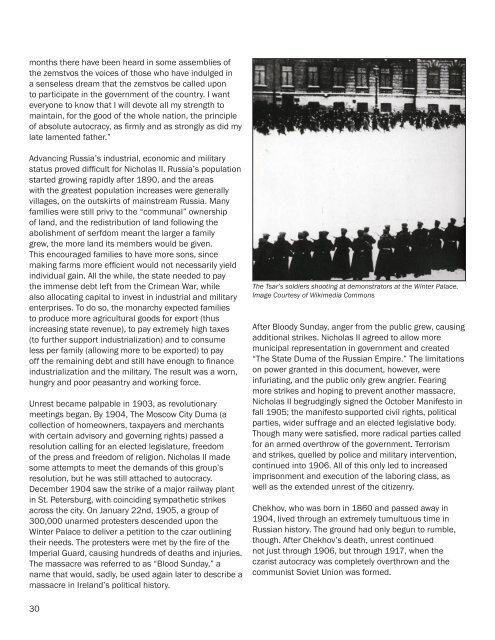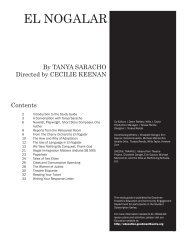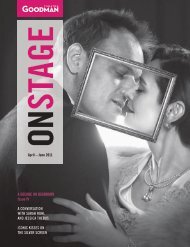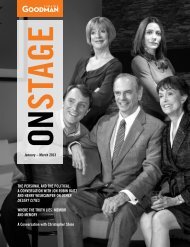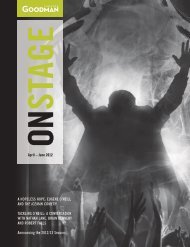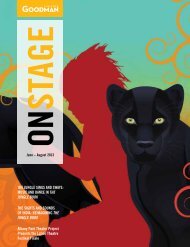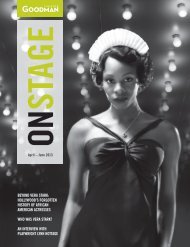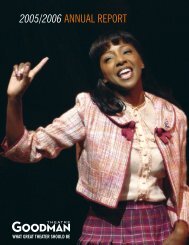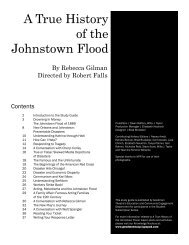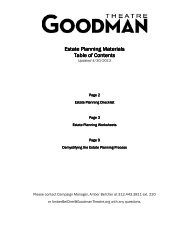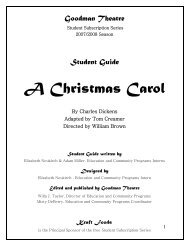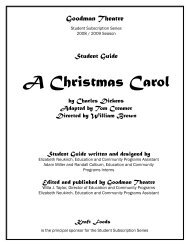The Seagull Study Guide (12MB) - Goodman Theatre
The Seagull Study Guide (12MB) - Goodman Theatre
The Seagull Study Guide (12MB) - Goodman Theatre
You also want an ePaper? Increase the reach of your titles
YUMPU automatically turns print PDFs into web optimized ePapers that Google loves.
months there have been heard in some assemblies of<br />
the zemstvos the voices of those who have indulged in<br />
a senseless dream that the zemstvos be called upon<br />
to participate in the government of the country. I want<br />
everyone to know that I will devote all my strength to<br />
maintain, for the good of the whole nation, the principle<br />
of absolute autocracy, as firmly and as strongly as did my<br />
late lamented father.”<br />
Advancing Russia’s industrial, economic and military<br />
status proved difficult for Nicholas II. Russia’s population<br />
started growing rapidly after 1890, and the areas<br />
with the greatest population increases were generally<br />
villages, on the outskirts of mainstream Russia. Many<br />
families were still privy to the “communal” ownership<br />
of land, and the redistribution of land following the<br />
abolishment of serfdom meant the larger a family<br />
grew, the more land its members would be given.<br />
This encouraged families to have more sons, since<br />
making farms more efficient would not necessarily yield<br />
individual gain. All the while, the state needed to pay<br />
the immense debt left from the Crimean War, while<br />
also allocating capital to invest in industrial and military<br />
enterprises. To do so, the monarchy expected families<br />
to produce more agricultural goods for export (thus<br />
increasing state revenue), to pay extremely high taxes<br />
(to further support industrialization) and to consume<br />
less per family (allowing more to be exported) to pay<br />
off the remaining debt and still have enough to finance<br />
industrialization and the military. <strong>The</strong> result was a worn,<br />
hungry and poor peasantry and working force.<br />
Unrest became palpable in 1903, as revolutionary<br />
meetings began. By 1904, <strong>The</strong> Moscow City Duma (a<br />
collection of homeowners, taxpayers and merchants<br />
with certain advisory and governing rights) passed a<br />
resolution calling for an elected legislature, freedom<br />
of the press and freedom of religion. Nicholas II made<br />
some attempts to meet the demands of this group’s<br />
resolution, but he was still attached to autocracy.<br />
December 1904 saw the strike of a major railway plant<br />
in St. Petersburg, with coinciding sympathetic strikes<br />
across the city. On January 22nd, 1905, a group of<br />
300,000 unarmed protesters descended upon the<br />
Winter Palace to deliver a petition to the czar outlining<br />
their needs. <strong>The</strong> protesters were met by the fire of the<br />
Imperial Guard, causing hundreds of deaths and injuries.<br />
<strong>The</strong> massacre was referred to as “Blood Sunday,” a<br />
name that would, sadly, be used again later to describe a<br />
massacre in Ireland’s political history.<br />
<strong>The</strong> Tsar’s soldiers shooting at demonstrators at the Winter Palace.<br />
Image Courtesy of Wikimedia Commons<br />
After Bloody Sunday, anger from the public grew, causing<br />
additional strikes. Nicholas II agreed to allow more<br />
municipal representation in government and created<br />
“<strong>The</strong> State Duma of the Russian Empire.” <strong>The</strong> limitations<br />
on power granted in this document, however, were<br />
infuriating, and the public only grew angrier. Fearing<br />
more strikes and hoping to prevent another massacre,<br />
Nicholas II begrudgingly signed the October Manifesto in<br />
fall 1905; the manifesto supported civil rights, political<br />
parties, wider suffrage and an elected legislative body.<br />
Though many were satisfied, more radical parties called<br />
for an armed overthrow of the government. Terrorism<br />
and strikes, quelled by police and military intervention,<br />
continued into 1906. All of this only led to increased<br />
imprisonment and execution of the laboring class, as<br />
well as the extended unrest of the citizenry.<br />
Chekhov, who was born in 1860 and passed away in<br />
1904, lived through an extremely tumultuous time in<br />
Russian history. <strong>The</strong> ground had only begun to rumble,<br />
though. After Chekhov’s death, unrest continued<br />
not just through 1906, but through 1917, when the<br />
czarist autocracy was completely overthrown and the<br />
communist Soviet Union was formed.<br />
30


